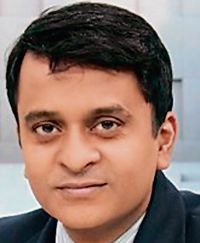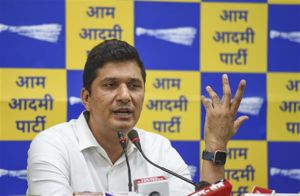
Contrast: The poorest of poor have lost out because of market reforms. PTI
Aunindyo Chakravarty
Senior Economic Analyst
When India got rid of the Raj, 74 years ago, we were known as the land of maharajas and beggars; a few super-rich with fabulous wealth on one side, and millions of extremely poor people on the other. Sovereign India set out to change that. But, seven decades later, it is clear that we have failed at this task. Estimates by the World Inequality Lab show that not only has India failed to provide a decent living to its poor, but also has failed to reduce the extreme inequality that existed when we became free. If anything, we are a more unequal nation today than ever before.
It is only the top 10 per cent of Indians who have gained significantly from the three-pronged economic policies of liberalisation, privatisation and globalisation.
The World Inequality Database tells us that in 1951, the share of national income of the top 1 per cent of Indians was the same as that of the bottom 40 per cent. Today, the richest 1 per cent earn as much as the bottom 67 per cent. In terms of share of total national wealth, in 1961 (the earliest year for which estimates are available), the richest 1 per cent owned as much as the poorest 50 per cent. Today, they have the same total wealth as the bottom 90 per cent of Indians.
Of course, it is possible for everyone to get reasonably affluent while a few people get extremely rich. This would show up as increased inequality, even when the average income of a majority of people rises. And there can be no doubt that India’s poor have a much better standard of living today than what they had 70 years ago. But is that sufficient?
One way to compare that is to see where we are in relation to the poorest 50 per cent of Americans, the world’s richest country. To do that, we need income data that adjusts not just for inflation across time, but for inflation across countries. Fortunately, the World Inequality Database gives us the required data. It shows that on an average, the poorest 50 per cent of Indians earn the same as what the poorest 50 per cent of Americans earned in 1932, right after the Great Depression devastated the US economy. So, in 70 years we have managed to raise our poor to the level to which America’s poor had crashed in the early 1930s.
Perhaps, this is because, enamoured with the supposed successes of central planning in the Soviet Union, we dabbled with ‘socialism’ for far too long. India began with ‘Nehruvian socialism’ and turned even more left in the 1970s under Indira Gandhi. It was only when she returned to power in 1980 that she began to liberalise India’s economy under ‘Operation Forward’. This was the first time that the state actively looked to bring in ‘market reforms’ and provide easier access to consumer goods to a growing middle class. Rajiv Gandhi accelerated the pace of privatisation and India formally broke with socialism with the Rao-Manmohan reforms of 1991.
During India’s ‘socialist’ phase, between 1951 and 1981, the economy grew at less than 4 per cent. The average real income of the poorest 50 per cent increased at just 2.2 per cent per year, while the top 1 per cent saw a marginal fall in their real income. Understandably, that meant the rich-poor gap reduced. By 1981, the top 1 per cent’s share of national income had dropped to the same as the bottom 28 per cent, compared to 40 per cent in 1951. But this was at the cost of a very slow real income growth. This changed during the reform period that has lasted for the past 40 years. India’s average GDP growth has jumped to nearly 6 per cent, and per adult GDP growth rate has doubled from 1.8 per cent per year in the socialist phase to 3.6 per cent in the ‘market reforms’ phase.
But what happened to the poor? In the socialist period, the average real income of the poorest 30 per cent grew at 2.3 per cent per year. Since then, it has dropped to 2.2 per cent. That means the poorest of India’s poor lost out because of market reforms. Take the bottom 50 per cent; their real income grew at 2.2 per cent per year between 1951 and 1981, and the growth rate remained exactly the same over the past 40 years. In other words, the poorest 50 per cent of Indians gained nothing from the huge growth in India’s GDP.
Those between the 60th and 90th percentile saw very marginal gains. In the socialist period, their average real income grew at 2.1 per cent per year, which increased to 2.3 per cent in the reforms period. It is only the top 10 per cent of Indians who have gained significantly from the three-pronged economic policies of liberalisation, privatisation and globalisation. And that too on a progressive scale. Those between the 90th and 99.5th percentile have seen a real income growth of between 2.7 and 5.6 per cent per year, while the richest 0.5 per cent achieved a real income growth of 6.7 per cent per year. Only the top 6 per cent of Indians have beaten the average per adult income growth rate of 3.6 per cent per year.
There could be no greater indictment of India’s tryst with market reforms. Privatisation and liberalisation have not only not benefited 90 per cent of Indians, but also have led to a massive increase in inequality. Today, the richest 10 per cent own 67 per cent of India’s wealth, and they control most of our productive assets. This inequality is not only economic, but also affects the entire edifice of the Indian nation state. The top 1 per cent, and their ‘aides’ in the next 9 per cent, control all institutions, guide public policy and dominate public discourse. They own and run media houses, deciding what people should know. They influence voter-behaviour by manufacturing consent.
Some would ask, if this were true, why don’t the remaining 90 per cent resist? The truth is that resistance is never automatic. Those who are at the receiving end of inequality often internalise the ideologies of the rich and perceive them to be the natural condition of things. That is the biggest victory of neoliberal pro-market economics, which is the ruling ideology of India’s ruling classes.
Join Whatsapp Channel of The Tribune for latest updates.




























